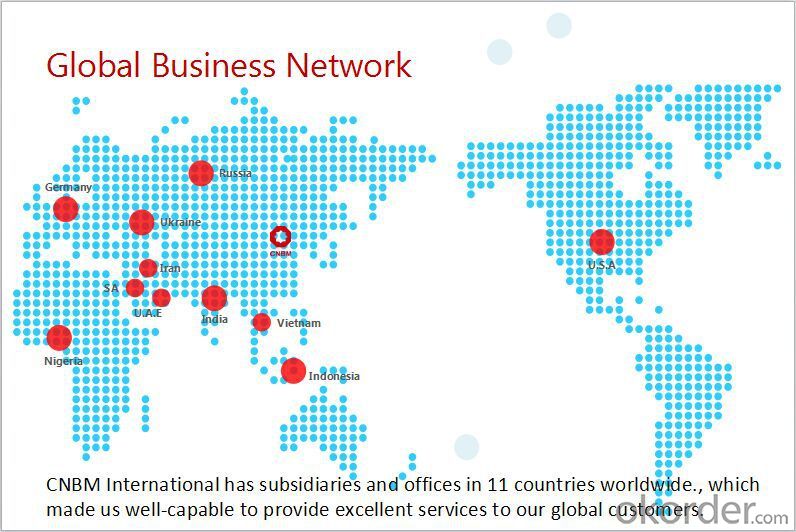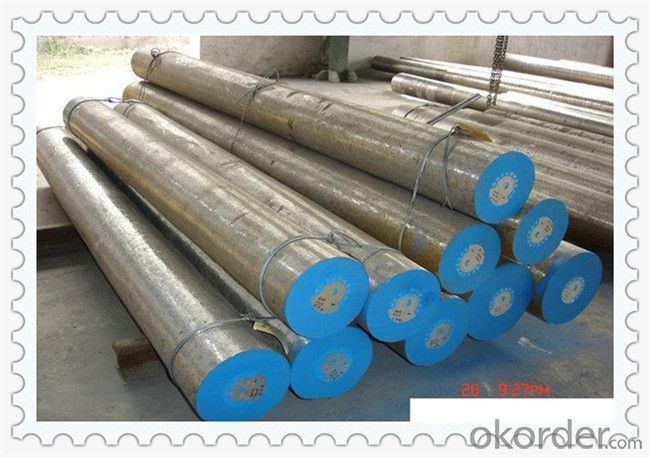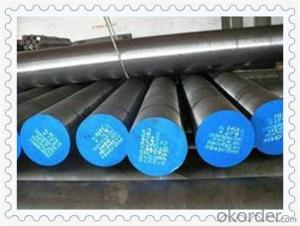Carbon Steel Rod Bar AISI 1050
- Loading Port:
- China main port
- Payment Terms:
- TT OR LC
- Min Order Qty:
- 30 m.t.
- Supply Capability:
- 10000 m.t./month
OKorder Service Pledge
OKorder Financial Service
You Might Also Like
Carbon Steel Rod Bar AISI 1050
Products Details
1, Size
Diameter : 10-1000mm
Length :1000-6000mm
2, Application
S50C structural carbon steel bar /1050 /50/C50 can be used to be manufactured forged gear, draw bar, roller,
shaft friction disc, shaft of machine tool, bent axle of engine, agricultural machanical plough share,
heavy load spindle and all kinds of shaft parts, minor damping spring and spring washer, etc.
3, Carbon Steel Round Bar Chemical Composition
Material | C | Si | Mn | S/P | B |
20# | 0.17-0.23 | 0.17-0.37 | 0.35-0.65 | 0.035(max) | 0.0008-0.003 |
25# | 0.22-0.29 | 0.17-0.37 | 0.50-0.80 | 0.035(max) | 0.0008-0.003 |
| 30# | 0.27-0.34 | 0.17-0.37 | 0.50-0.80 | 0.035(max) | 0.0008-0.003 |
35# | 0.32-0.39 | 0.17-0.37 | 0.50-0.80 | 0.035(max) | 0.0008-0.003 |
40# | 0.37-0.44 | 0.17-0.37 | 0.50-0.80 | 0.035(max) | 0.0008-0.003 |
45# | 0.42-0.48 | 0.17-0.37 | 0.50-0.80 | 0.035(max) | 0.0008-0.003 |
50# | 0.47-0.55 | 0.17-0.37 | 0.50-0.80 | 0.035(max) | 0.0008-0.003 |
55# | 0.52-0.60 | 0.17-0.37 | 0.50-0.80 | 0.035(max) | 0.0008-0.003 |
60# | 0.57-0.65 | 0.17-0.37 | 0.50-0.80 | 0.035(max) | 0.0008-0.003 |
4, Grade Equivalent
| GB | 20# | 30# | 35# | 40# | 45# | 50# | 55# | 60# |
| JIS | S20C | S30C | S35C | S40C | S45C | S50C | S55C | S60C |
| ASTM | 1020 | 1030 | 1035 | 1040 | 1045 | 1050 | 1055 | 1060 |
| C60 | ||||||||
| DIN | C22 | C30 | C35 | C40 | C45/CK45 | C50 | C55 | |
5, Characteristics
- High-hardness medium carbon structural steel.
- Low cold deformation ability and medium machinability.
- Poor weldability without temper brittlement.
- Low hardenability.
- Cracks is often caused during water quenching process.
- Using condition: normallizing and tempering after quenching and quenching on the high-frenquency surface.
- S50C/ 1050/ 50 can be used to be manufactured the machanical parts with high abrasice resistance
which can be used unde the condition of low dynamic load and impact effect.
6, Tests
HIC, SSC, SPWHT, Macrostructure, detection of defects, Hardness and DWTT test for pipelines steel plates are also available.
7, Surface Treatment
Black, chromate, fingerprint resistant treatment, slight oiled or non-oiled, dry.
Products Show

Product Overviews
| Product Name | Typical Grades | Diameter(mm) | Standard adopted |
| Carbon Steel | 20 (1020/S20C/C22) | Ø16-Ø300 |
GB/SAE/JIS/DIN
|
| 40 (1040/S40C/C40) | |||
| 45 (1045/S45C/C45) | |||
| Bearing Steel | GCr9 (51100/SUJ1) | Ø12-Ø250 | |
| GCr15 (52100/SUJ2/100Gr6) | |||
| GCr9SiMn (A485-Gr.1/SUJ3) | |||
Cr-Mo Steel | 20Cr (5120/SCr420H/20Cr4) | Ø12-Ø250 | |
| 40Cr (5140/SCr440/41Cr4) | |||
| 42CrMo(4140/SCM440/42CrMo4) | |||
| Gear Steel | 20CrNiMo | Ø16-Ø600 | |
| 20CrMn(5115/SMnC420/20MnCr5) | |||
| 20CrNiMo(8620/SNCM220/20CrMiMo2) |
Application
| Carbon Steel | Mold bottom, Plastic mold, Construction machinery parts Automobile parts, Security grills, Screens, Construction |
| Bearing Steel | Aerospace, Navigation, Nuclear energy, Chemical industry Electronic information, Petrochemical, Instrument and meter Transportation |
| Cr-Mo Steel | Mechanism & Fasteners gear, Stressed components for vehicles Engines and machines, Parts of larger cross-section |
| Gear Steel | All kinds of gears, Statically and dynamically stressed component for vehicles Engines and machine, Larger cross-section parts, Crankshafts |
Work Shop

Company Information
CNBM International Corporation is the most important trading platform of CNBM group.
Whith its advantages, CNBM International are mainly concentrate on Cement, Glass, Iron and Steel, Ceramics industries and devotes herself for supplying high qulity series of refractories as well as technical consultancies and logistics solutions.


FAQ
1, Your advantages?
professional products inquiry, products knowledge train (for agents), smooth goods delivery, excellent customer solution proposale
2, Test & Certificate?
SGS test is available, customer inspection before shipping is welcome, third party inspection is no problem
3, Factory or Trading Company?
CNBM is a trading company but we have so many protocol factories and CNBM works as a trading department of these factories. Also CNBM is the holding company of many factories.
4, Payment Terms?
30% TT as deposit and 70% before delivery.
Irrevocable L/C at sight.
5, Trading Terms?
EXW, FOB, CIF, FFR, CNF
6, After-sale Service?
CNBM provides the services and support you need for every step of our cooperation. We're the business partner you can trust.
For any problem, please kindly contact us at any your convenient time.
We'll reply you in our first priority within 24 hours.
Packaging & Delivery
1, Packaging: seaworthy package or as required
2, Delivery: 35-45 days or based on quantity

- Q: On the market, 8mm Round Bar is not 9 meters a root? How much does it weigh about 300 meters? How much does it cost?
- 8 there is no regular reinforced steel bars are straight, round, there is straight, as you said 9 M 1, but that's rolling, if their home, can also, engineering is prohibited
- Q: Can steel round bars be used for pump shaft applications?
- Indeed, pump shaft applications can make effective use of steel round bars. The prevalence of steel round bars in pump shafts can be attributed to their exceptional strength, durability, and resistance against corrosion. Considering the high torsional loads pump shafts face and the necessity to endure the strains of rotating machinery, steel round bars provide the essential mechanical attributes to withstand these circumstances, rendering them an apt selection for pump shaft applications. Moreover, the adaptability of steel permits diverse heat treatments and surface finishes to amplify its efficiency and longevity in pump shafts.
- Q: What is the reason that the diameter 130-45 round steel will break after welding?
- You say this is a better situation, generally in a few days after welding on the crack, the most afraid of the key parts, to be a major accident. No. 45 steel can not be welded, such as welding, it is necessary to preheat before welding and after welding heat treatment.
- Q: Can steel round bars be threaded?
- Yes, steel round bars can be threaded. Threading refers to the process of cutting threads onto the surface of a cylindrical object, such as a steel round bar, to create a screw-like shape. This allows the bar to be securely fastened into a corresponding threaded hole or to join with another threaded component. Threading can be done using different methods, such as manual threading with a die or using machine tools like lathes or thread rolling machines. The specific method used depends on the size and type of thread required. However, it is important to note that not all steel round bars are suitable for threading, as the material composition and hardness of the steel can affect the threading process. Therefore, it is recommended to consult with a professional or experienced personnel to ensure the steel round bar is suitable for threading and to determine the appropriate threading method.
- Q: Can steel round bars be used for making shafts?
- Steel round bars are capable of being utilized for the production of shafts. Owing to their exceptional strength and durability, steel round bars find widespread use in various industries for the purpose of shaft fabrication. They possess the ability to endure heavy loads, withstand forces that induce bending and twisting, and exhibit remarkable performance in applications where power transmission or rotational movement is required. Moreover, steel round bars offer commendable machinability, enabling effortless shaping and formation into shafts of diverse sizes and dimensions. Furthermore, heat treatment can be employed to augment the strength and hardness of steel round bars, rendering them even more suitable for shafts operating in demanding environments. In conclusion, steel round bars are an immensely popular choice for shaft production due to their inherent properties and unwavering reliability across a multitude of industrial applications.
- Q: Which is hard, round steel or screw steel?
- Round bar is divided into three parts: hot rolling, forging and cold drawing. Standard Specification for hot rolled round steel is 5.5-250 mm. Of them: 5.5-25 mm small round bars are mostly supplied by straight strips. They are used as reinforcing bars, bolts and various mechanical parts. They are more than 25 millimeters of round steel. They are mainly used in the manufacture of mechanical parts or seamless steel tube billets
- Q: Can steel round bars be used for making hydraulic systems?
- Steel round bars can indeed be used for making hydraulic systems. Steel is a durable and strong material that can withstand high pressure and extreme conditions, making it suitable for hydraulic applications. Steel round bars can be machined and shaped into various components such as cylinders, pistons, and shafts, which are essential parts of hydraulic systems. Additionally, steel is resistant to corrosion, which is crucial for hydraulic systems that often come into contact with fluids. However, it is important to ensure that the steel round bars used for hydraulic systems meet the necessary specifications and requirements, such as hardness, tensile strength, and dimensional accuracy, to ensure optimal performance and reliability.
- Q: How do you calculate the fatigue strength of a steel round bar?
- Various methods can be employed to calculate the fatigue strength of a steel round bar. For instance, the stress-life (S-N) curve approach or the strain-life (ε-N) curve approach can be utilized. The stress-life (S-N) curve approach entails plotting the stress amplitude (S) against the number of cycles to failure (N) on a log-log scale. By subjecting multiple specimens of the steel round bar to different stress levels and measuring the number of cycles to failure for each stress level, the S-N curve can be obtained. The fatigue strength of the steel round bar can then be determined by identifying the stress level at which the desired number of cycles to failure is achieved, commonly known as the endurance limit. On the other hand, the strain-life (ε-N) curve approach involves plotting the strain amplitude (ε) against the number of cycles to failure (N) on a log-log scale. Similar to the S-N curve approach, multiple specimens of the steel round bar are subjected to different strain levels, and the number of cycles to failure is recorded. By utilizing the strain-life curve, the fatigue strength can be determined by identifying the strain level corresponding to the desired number of cycles to failure. It should be emphasized that calculating the fatigue strength of a steel round bar necessitates conducting fatigue tests on representative specimens under controlled conditions. These tests involve subjecting the specimens to cyclic loading, typically in the form of tension-compression cycles, and recording the number of cycles to failure. The data obtained from these tests is then utilized to construct the S-N curve or the ε-N curve, which offers valuable insights into the fatigue behavior and strength of the steel round bar.
- Q: What are the different types of steel round bar alloys for improved corrosion resistance?
- There are several different types of steel round bar alloys that offer improved corrosion resistance. Some common examples include stainless steel alloys such as 304, 316, and 410, which contain chromium and nickel to create a protective layer against corrosion. Additionally, weathering steel alloys like ASTM A588 and A709 are known for their ability to develop a rust-like appearance that acts as a protective barrier. Other options include duplex stainless steels, which combine the benefits of austenitic and ferritic alloys, and high-alloy steels like Inconel and Hastelloy, which are highly resistant to corrosion in extreme environments.
- Q: Can steel round bars be used in the production of industrial machinery?
- Steel round bars are indeed applicable for the production of industrial machinery. They are extensively employed in the manufacturing of diverse components and parts for industrial machinery due to their remarkable strength, durability, and versatility. These bars are capable of generating shafts, gears, rollers, and other vital elements that are indispensable for the appropriate operation of industrial machinery. The exceptional tensile strength of steel round bars enables them to endure substantial loads and resist deformation, rendering them an optimal choice for industrial applications. Furthermore, steel round bars can be effortlessly machined, welded, and fashioned into various shapes and sizes, thereby making them extremely suitable for customization in accordance with specific machinery requirements.
Send your message to us
Carbon Steel Rod Bar AISI 1050
- Loading Port:
- China main port
- Payment Terms:
- TT OR LC
- Min Order Qty:
- 30 m.t.
- Supply Capability:
- 10000 m.t./month
OKorder Service Pledge
OKorder Financial Service
Similar products
Hot products
Hot Searches
Related keywords


































